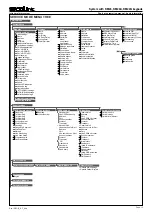
NC t
ype detector
(BK2, BK3, BK4)
2
1
0
input terminal 1, 2 or 3.
Z
one
response
(speed)
time of
0,4
sec.
Short programming manual - basic information
Intruder alarm system
System with
KM24, KM24A
, KM24G keypads
Z01 Door
Address
00_1
2
Zone address is a 3-digit number represented in MA_Z format, where MA specifies a module address in the
system and
Z
specifies a zone terminal in the module board. Example:
00_1
-
where
00 means the control panel
and 1 means zone terminal Z1. To program a doubled zone - detectors A and B must be specified. Use keypad
keys [A] or [B] to specify these detectors in the zone address field (example: 00_1 A, 00_1 B, ...).
Note:
use loop types
NO/DEOL
or
NC/DEOL
for the doubled zones.
For a keypad firmware version to v.5.xxx, wireless zone loop type depends on zone address. For wireless zones
MA_1 – MA_8 the system will automatically assign
NO/DEOL
loop type and for wireless zones MA_9 – MA_16
the
Vibration
loop type. Do not change the loop type of the zone!
For a keypad firmware version v.5.xxx or higher the loop type is
Wireless
for all wireless zones MA_1 – MA_16.
Wireless m
odule address
:
EXT116S -
address
06
(
default
)
or one that is given during the registration process.
Virtual
wireless
module EXT116
VM
address:
P16 -
address
12
;
P32 -
address
12
and
13
;
P64 -
address
12
,
13
,
14
and
15
.
Z01 Door
Loop Type
NC
3
The
Loop type
menu enables you to program the connection type used for each of the system’s zones. The
actual (physical) loop type for each zone must comply with that selected in the
Loop type
menu. Available loop
types:
Not used
NC -
uses normally closed contacts and no end of line resistor;
NO -
uses normally open contacts and no end of line resistor;
NC/EOL -
uses normally closed (NC) contacts in a zone terminated by a 1k end of line resistor;
NO/EOL -
uses normally open (NO) contacts in a zone terminated by a 1k end of line resistor;
NC/DEOL -
uses normally closed (NC) contacts in a zone using at least two 1k end of line resistors to
distinguish between alarms and tamper conditions;
NO/DEOL -
uses normally open (NO) contacts in a zone using at least two 1k end of line resistors to
distinguish between alarms and tamper conditions;
Vibration -
special purpose zone loop type;
Roller -
special purpose zone loop type
(exluding PAS808M)
;
Wireless
Z01 Door
Address
00_1 A
2
Z01 Door
Address
00_1 B
2
Page 5
Wireless detectors can be enrolled
using serial number in a system with following firmware version or higher:
control panel P16, P32, P64 – v.5.00;
wireless zone expansion module EXT116S – v.5.000;
keypads KM24, KM24A arba KM24G – v.5.000;
keypads KM25 – v.5.000;
software MASCAD – v.1.9403;
GSM/GPRS communicator GSVU or GSV6U – v.5.000;
LAN communicator LAN800 – v.5.00.
Enrolment using serial number is a two step process
:
1 step.
Enter detector serial number. The keypad will identify the detector's type and will show all other
related settings that are required for enrolment.
2 step.
SERVICE MODE DOES NOT HAVE TO BE ENTERED AT THIS STEP! To complete enrolment,
the detector must be activated to send a signal to the receiver. It could be done by triggering the detector’s
loop (zone) OR by pressing the tamper switch. All wireless detector zones that are still not activated, therefore
not enrolled, are marked with a phrase
Not activ.
in menu
Wireless communication.
Z01 Door
Model
Loop (zone)
Detect tamper
Battery
Operation code
Serial No.
4
8388608
BK4
Magnetas
Taip
ER14250
201
5
Z01 Door
Serial No.
4
N/A
When the detector is successfully enrolled, the mode
LR
or
ES
will be displayed in the row. Phrase
No SN
.
will be
displayed when wireless zone is enabled, but serial number of the detector is not entered. Phrase
only LR
will be
displayed when the detector supports only the
LR
mode (firmware version < 2.000).
}
Techn
ical information
}
Wireless communication
Wireless communication
Entry doors
Window
Living room
Kitchen
Detector status
1
Not activ.
LR
No SN.
only LR
2
3
4
Z01 Door
Operation code
N/A
4
Wireless detector can also be enrolled using
Operation code
. Enter wireless detector’s
peration code
and
O
press
the [ENT] key. When enrolment has started, immediately press the detector's tamper switch for a short
period of time (~1 sec).
200
Temperature
(BT1)
201
Magnet
(BK1, BK4)
Water leakage
detector (BF1)
0
10
181
Motion
(BP2)
180
Temperature
(BP2)
Wireless output BS100.
the LAST digit of the
Operation code
which
Important
!
was
used for enrolling BS100 indicates the wireless PGM output number in the module.
1
02
1
03
1
04
1
05
Input terminal (1, 2, 3).
2
1
1
L
ast digit defines the number of Roller
pulses
(1, 2, 3, 4, 5, 7, 9).
D
elete
single
detector
254
Delete all detectors
from module
255
































